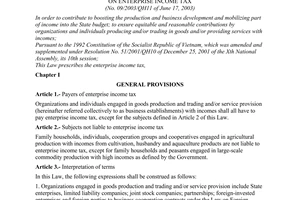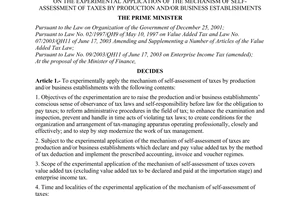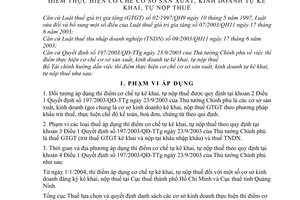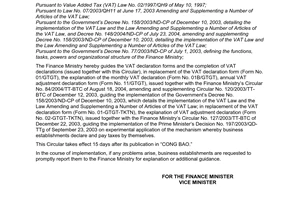Nội dung toàn văn Circular No. 127/2003/TT-BTC of December 22, 2003 guiding the implementation of The Prime Minister’s Decision No. 197/2003/QD-TTg of September 23, 2003 on experimental application of mechanism of self-assessment of tax by production and/or business establishments
|
THE MINISTRY OF FINANCE |
SOCIALIST REPUBLIC OF VIET NAM |
|
No. 127/2003/TT-BTC |
Hanoi, December 22, 2003 |
CIRCULAR
GUIDING THE IMPLEMENTATION OF THE PRIME MINISTER’S DECISION NO. 197/2003/QD-TTG OF SEPTEMBER 23, 2003 ON EXPERIMENTAL APPLICATION OF MECHANISM OF SELF-ASSESSMENT OF TAX BY PRODUCTION AND/OR BUSINESS ESTABLISHMENTS
Pursuant to May 10, 1997 Value Added Tax (VAT) Law No.
02/1997/QH9 and June 17, 2003 Law No. 07/2003/QH11 amending and supplementing a
number of articles of the Value Added Tax Law;
Pursuant to June 17, 2003 Law No. 09/2003/QH11 on Enterprise Income Tax (EIT);
Pursuant to the Prime Minister’s Decision No. 197/2003/QD-TTg of September 23,
2003 on experimental application of the mechanism self-declaration of tax and
self-payment of tax by production and/or business establishments,
The Finance Ministry hereby guides the experimental application of the
mechanism of self-assessment of tax by production and/or business
establishments as follows:
I. SCOPE OF APPLICATION
1. Subjects of experimental application of the tax self-assessment mechanism prescribed in Clause 2, Article 1 of the Prime Minister’s Decision No. 197/2003/QD-TTg of September 23, 2003 shall be production and/or business establishments (called collectively business establishments) which declare and pay VAT by deduction method and follow the prescribed regimes of accounting, invoices and vouchers.
2. Taxes covered by the experimental application of tax self-assessment as provided for in Clause 3, Article 1 of the Prime Minister’s Decision No. 197/2003/QD-TTg of September 23, 2003 shall be VAT (excluding VAT declared and paid at the importation stage) and EIT.
3. The time and places of experimental application of the tax self-assessment mechanism under the provisions of Clause 4, Article 1 of the Prime Minister’s Decision No. 197/2003/QD-TTg of September 23, 2003 shall be as follows:
As from January 1, 2004, the tax self-assessment mechanism shall be experimentally applied to a number of business establishments which register, declare and pay taxes at the Tax Department of Ho Chi Minh City and the Tax Department of Quang Ninh province.
The General Department of Tax shall select and decide on the list of business establishments for experimental application of tax self-assessment mechanism.
II. TAX REGISTRATION, TAX DECLARATION, TAX PAYMENT
1. Tax registration:
Business establishments experimentally applying the tax self-assessment mechanism shall continue using the tax identification numbers granted by tax offices, without having to re-register tax with tax offices. In the course of experimental application, if business establishments make any changes in the contents of information on tax registration, they must make additional registration with the directly managing tax offices according to the current regulations on tax registration.
2. VAT declaration, payment:
a) VAT declaration:
- VAT shall be calculated and registered monthly. The business establishments experimentally applying the tax self-assessment mechanism are obliged to monthly declare VAT in full according to the declaration form set by the Finance Ministry (Form No. 01-GTGT-TKTN issued together with this Circular), not enclosed with lists of goods, services purchased, sold. In cases where business establishments have no goods and service sale turnovers, no input and output tax, they shall still have to declare and submit the declarations to tax offices.
- The business establishments must declare their tax identification numbers, names, addresses and other relevant information as having already registered tax with tax offices. In cases where they fail to fully declare according to the set forms or have not yet certified the legality of their declarations (affixed with signatures, stamps), the business establishments shall be considered having not yet submitted their declarations to the tax offices.
- The deadline for submitting the monthly VAT declarations shall be the 25th of the following month. Business establishments shall submit their declarations via post offices or directly at tax offices. The declaration submitting dates shall be determined as the post mark dates of delivery (for cases of sending declarations by post) or the dates the business establishments submit their declarations directly at tax offices.
- The business establishments shall be answerable to law for the truthfulness and accuracy of their monthly VAT declaration. In cases where tax offices detect through examinations and inspections that the data on the declarations are untruthful, inaccurate, the business establishments shall be sanctioned under law provisions.
b) VAT adjustment declaration:
- After submitting their declarations to tax offices, if business establishments made errors or mistakes in the declared data (detected by the business establishments themselves or notified by tax offices), they shall have the responsibility to declare the adjustment with tax offices:
+ If the prescribed declaration time limit has not yet expired, the business establishments may make and submit new declarations substituting for the old ones already submitted to the tax offices. The substituting declarations must clearly state the substitution of the declarations already sent to tax offices on which date;
+ If the prescribed declaration time limit has expired, the business establishments shall make adjustments on the lines reserved for adjustments on the declaration of the period in which errors are detected (the business establishments submit the declarations enclosed with the written explanations of VAT adjustments made according to Form No. 02-GTGT-TKTN issued together with this Circular). Where tax offices already issued notices on inspection or examination decisions, the business establishments must not declare the adjustments.
- The experimentally applying business establishments shall not have to make annual tax settlements with tax offices, but must monthly examine invoices, vouchers and accounting books of the preceding month so as to detect in time tax amounts not yet declared or tax amounts paid at variance with the payable tax amounts in order to promptly declare adjustments, supplements to the declarations of the following months.
- Where business establishments cannot separately account the deductible input VAT on goods and services used for production and/or trading of goods and services subject to VAT and not subject to VAT, the input tax shall be calculated by deduction in percentage (%) of the sale turnover of VAT-liable goods and/or services against the total goods and/or service sale turnover.
The business establishments shall deduct input tax in percentage temporarily calculated every month. When making the declaration of the 12th month, the business establishments shall re-calculate the deductible input tax amounts in percentage of the turnovers of 12 months. In case of disparity between sale turnovers on the VAT declarations of the months in a year and the turnover of the year according to the financial statements, the business establishments may declare the adjustment of the deductible input VAT within 90 days counting from the day ending the calendar year or the fiscal year.
c) VAT payment:
Monthly, the business establishments shall pay VAT into the State budget according to the declared tax amounts. The VAT payment deadline shall not be later than the deadline for submission of the tax declaration of the declaration month. For business establishments paying tax by transfer via banks or other credit institutions, the date of paying tax into the State budget shall be determined as the dates the banks or other credit institutions sign for reception on papers of money payment into the State budget; for business establishments paying tax in cash, the date of paying tax into the State budget shall be determined as the dates the treasuries receive the tax money.
The business establishments shall fully inscribe the indexes on the payment papers under the guidance of the tax offices and the State treasuries. The business establishments must clearly inscribe on the payment papers the tax amounts, fine amounts paid corresponding to each kind of tax, each period of tax calculation. Where business establishments have the tax amounts and fine amounts payable in the period and also the outstanding tax and fine amounts of the previous periods but fail to inscribe for which tax calculation period the payment is made, the tax offices shall subtract the outstanding tax and/or fine amounts before subtracting the tax and/or fine amounts payable in the period.
d) In case of merger, consolidation, division, separation, dissolution, bankruptcy, ownership transformation; assignment, sale, contracting or lease of state enterprises, the business establishments must declare the tax amounts arising by the time of merger, consolidation, division, separation, dissolution, bankruptcy, ownership transformation, assignment, sale, contracting, lease (including the declaration of adjustments of the previous periods’ data if errors are detected). The business establishments must submit the tax declarations and fully pay the outstanding VAT amount into the State budget within 45 days after the issuance of decisions on merger, consolidation, division, separation, dissolution, bankruptcy, ownership transformation, assignment, sale, contracting or lease of State enterprises. In case of tax amounts overpaid or not fully deducted, the business establishments shall be refunded by tax offices according to current regulations.
3. EIT declaration and payment:
a) Quarterly declaration and temporary payment of EIT:
- The business establishments shall determine by themselves the EIT amounts temporarily paid every quarter according to Form No. 03-TNDN-TKTN (issued together with this Circular). The business establishments shall submit the quarterly payable EIT amount determination table to the tax offices and at the same time pay tax money into the State budget by the 25th of the first month of the quarter at the latest.
- The EIT temporarily paid every quarter shall be determined as follows:
The The quarter’s The
percentage of
temporarily paid = sales x taxable
income x EIT rate
EIT amount revenue on
sales turnover
In which:
+ Sales revenue for calculation of taxable income of the quarter is the total revenue exclusive of VAT on sold goods, services of three months in the quarter (based on the VAT declarations of the months in the quarter).
+ The percentage of taxable income over turnover (the temporary payment percentage) is the percentage of taxable income over the preceding year’s turnover based on the preceding year’s EIT declaration. In cases where business establishments were inspected or examined and the percentage of taxable income over turnover according to the inspection or examination results of the tax offices differ from the percentage already declared by the business establishments, it shall be determined according to the results of inspection or examination by tax offices.
- Where the preceding year’s percentage of taxable income over turnover cannot be determined (business establishments suffer losses or are newly set up), the business establishments shall base themselves on the practical production and business situation of the quarter and the projection of the year to determine the temporary payment percentage (after offsetting the preceding year’s losses according to tax law).
- Where the results of goods production and sale as well as service provision in the first six month of the year see a big change, leading to the 20%-plus increase of the percentage of taxable income over revenue of the preceding year, the business establishments must adjust the temporary EIT payment percentages of the two last quarters of the year; where the results of goods production and sale as well as service provision in the first six month of the year see a big change, leading to the 20%-plus decrease of the percentage of taxable income over the preceding year’s turnover, the business establishments may adjust the temporary EIT payment percentage of the two last quarters of the year and must send their written explanations of the causes, reasons therefor to the tax offices together with the documents showing production and/or business fluctuation. In cases where tax offices detect through inspection that the adjustment is irrational, they may fix the temporary payment percentage.
Example: In 2001, the percentage of taxable income over turnover determined at the EIT declaration of a business establishment is 10%. Therefore, such establishment shall temporarily pay EIT for the first and second quarters at the rate of 10%. After the first six months of 2002, the establishment’s business declines, leading to the decrease of the percentage of taxable income over turnover:
+ Case 1: The percentage decreases to 8%. The business establishment may adjust the temporary payment rate in the third and fourth quarters to 8% (due to the fluctuation of the percentage of taxable income over turnover is: (10-8)/10 = 20%).
+ Case 2: The percentage decreases to 9%. The business establishment is not allowed to adjust the temporary payment percentage in the third and fourth quarters, but keeps paying at the rate of 10% (as the fluctuation of the percentage of taxable income over turnover is: (10-9)/10 = 10%).
b) Annual EIT declaration and payment:
- At the end of a calendar year of a fiscal year, the business establishments shall declare EIT according to Form No. 04-TNDN-TKTN issued together with this Circular.
- The time limit for submission of tax declaration shall be 90 days counting from the end or the calendar year or the fiscal year. The way of determining the declaration-submitting dates shall be the same as for VAT.
- Basing themselves on the payable tax amounts declared in the annual EIT declarations, the business establishments shall fully pay the outstanding tax amounts into the State budget within 90 days counting from the end of the calendar year or the fiscal year; the overpaid amounts, if any, shall be subtracted from the payable tax amounts of the subsequent period of temporary tax payment declaration. The way of determining tax payment date and the priority order of EIT payment shall be the same as for VAT.
- The business establishments are answerable to law for the truthfulness and accuracy of their declarations. In cases where tax offices detect through inspection or examination that the data on the declarations are untruthful and inaccurate, the business establishments shall be sanctioned according to law provisions.
- The business establishments shall settle EIT of 2003 according to the EIT settlement form issued together with Circular No. 18/2002/TT-BTC of February 20, 2002. As from the end of 2004, the business establishments shall make annual EIT declarations according to set form (Form No.04-TNDN-TKTN) issued together with this Circular.
c) EIT exemption, reduction
Business establishments shall determine by themselves the tax preferences they enjoy in the year (the preferential EIT rates, the tax exemption level, the EIT reduction level) according to the prescribed regimes, the exempted or reduced EIT amounts except when calculating the EIT amount temporarily paid every quarter.
At the end of the calendar year or the fiscal year, the business establishments shall re-calculate the EIT tax amounts exempted or reduced and clearly explain the determination grounds and send them to the tax offices together with the annual EIT declarations.
d) Annual EIT adjustment declaration:
- After submitting the declarations to tax offices, if business establishments made errors or mistakes in the declared data (detected by the establishments themselves or notified by tax offices), they shall have to declare the adjustments with the tax offices:
+ If the prescribed declaration-submitting time limit has not yet expired, the business establishment may submit the adjusted declarations to replace the old declarations already submitted to the tax offices. The substituting declarations must clearly state the replacement of the declarations already submitted to the tax offices on which dates;
+ If the prescribed declaration-submitting time limit has already expired, the business establishments shall submit the declarations supplementing, amending the adjusted indexes, clearly stating the adjusted period, the contents and codes of the adjusted indexes, declared data, the number proposed for adjustment, the adjustment reasons and the EIT increase (or decrease) amounts due to adjustment, with signatures and stamps. Where the tax offices issued notices on inspection or examination decisions, the business establishments must not declare the adjustment.
e) In case of merger, consolidation, division, separation, dissolution, bankruptcy, ownership transformation, the business establishments must declare the annual EIT to the time of merger, consolidation, division, separation, dissolution, bankruptcy, transformation of enterprises. The business establishments shall submit the tax declarations and fully pay the outstanding EIT amounts into the state budget within 45 days after the issuance of decisions on transformation of enterprises, ownership transformation, merger, consolidation, division, separation, dissolution, bankruptcy, transformation of enterprises. In case of overpaid tax amounts, the business establishments shall be refunded by tax offices according to current regulations.
III. TASKS, POWERS AND RESPONSIBILITIES OF TAX OFFICES
Apart from the tasks, powers and responsibilities prescribed in various legal documents on tax and the relevant legal documents, the tax offices managing the business establishments which experimentally apply the tax self-assessment mechanism shall have the responsibilities:
1. To propagate, disseminate, guide and answer queries of business establishments in tax policies, tax declaration and payment procedures so that they understand and correctly implement law provisions on tax and the tax self-assessment mechanism.
2. To monitor the performance of tax declaration and tax payment obligations of business establishments:
- Past the prescribed declaration-submitting time limit, the tax offices shall send notices reminding the business establishments, which have not yet submitted the tax declarations, to submit them and sanction their administrative violations according to the current regulations. In cases where after being notified and reminded of the declaration submission and being sanctioned for administrative violations, the business establishments still do not submit the declarations, the tax offices shall fix the tax amounts to be temporarily paid according to the provisions of tax law.
- Past the prescribed declaration-submitting time limit, the tax offices shall send notices reminding the business establishments, which have not yet paid or have not fully paid tax, to pay tax and at the same time calculate fines on late payment of tax arrears into the State budget according to regulations.
3. To conduct inspection, examination of tax declaration and payment by business establishments.
4. To apply coercive measures to collect tax arrears and fines.
For production and/or business establishments which have not paid tax and/or fines according to tax notices or tax handling decisions, the tax offices shall apply the following measures:
- Requesting banks, other credit institutions or treasuries to deduct the business establishments’ money deposited at such banks, credit institutions or treasuries for payment of tax and/or fines.
- Seizing goods, material evidences to ensure the full collection of tax and fines.
- Distraining assets according to law provisions in order to ensure the full collection of outstanding tax and/or fine amounts.
5. To keep secret the supplied information on experimenting production and/or business establishments according to regulations.
IV. IMPLEMENTATION ORGANIZATION
1. This Circular takes implementation effect 15 days after its publication in the Official Gazette. The experimental application of tax self-assessment by business establishments as provided for in this Circular shall be effected as from January 1, 2004.
2. Apart from the contents prescribed in this Circular, the regulations on tax calculation bases, tax calculation methods, tax rates, tax exemption, reduction and reimbursement, violation handling, commendation and other regulations shall comply with the provisions of VAT Law and EIP Law.
3. The General Department of Tax shall have to organize the experimental application of tax management under tax self-assessment mechanism.
4. In the course of implementation, if difficulties or problems arise, the business establishments shall promptly report them to the Finance Ministry for study and additional guidance.
|
ATTACH FILE
|




